|
|
|
Sort Order |
|
|
|
Items / Page
|
|
|
|
|
|
|
| Srl | Item |
| 1 |
ID:
167093


|
|
|
|
|
| Summary/Abstract |
Al-Gama’a [The Society], a 28-part television biopic of Muslim Brotherhood founder Hasan al-Banna, was broadcast in the fall of 2010, just before the January 25, 2011 Revolution. The writer of the series, Wahid Hamid, was an important screenwriter for both television and the cinema and a figure known for his affinity with the state’s security apparatus. Al-Gama’a functioned as a rhetorical capstone for decades of anti-Brotherhood state discourse. It also powerfully anticipated the anti-Brotherhood apologetics used to rationalize the Rab‘a massacre of 2013, which effectively ended the revolution and cemented the coup by ‘Abd al-Fattah al-Sisi against Muhammad Morsy. The series enacted a historical narrative that was almost completely absent from Egypt’s formal educational curriculum, thereby furthering a political agenda of dehumanizing Islamists and effectively excommunicating them from the national community. Hence in 2013, a thousand Egyptians were slaughtered in a day, and yet many of their fellow citizens saw the event as destiny rather than as a crime against humanity.
|
|
|
|
|
|
|
|
|
|
|
|
|
|
|
|
| 2 |
ID:
167086
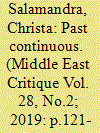

|
|
|
|
|
| Summary/Abstract |
Syria serves as a leading producer of the musalsal [dramatic miniseries], a key Arabic-language mass cultural form. With its dark realism and biting humor, Syrian drama has become a primary mode of sociopolitical commentary for both producers and audiences, given the restrictions on journalistic and academic expression and the absence of participatory politics in most Arab polities. Drama creators deploy a range of temporal strategies to comment on social and political conditions. A reflexive, intertextual chronopolitics runs through serials produced before and during the Syrian conflict that began in 2011. The question ‘what went wrong?’ preoccupies musalsal makers, and their works frequently foreground their belief that Syrian society is ‘going backwards.’ For example, in historical genres of television serials, idealized images harken back to perceived golden ages of cosmopolitanism, throwing the contemporary condition into bitter relief. Makers of dramas set in the present invert this technique, locating the sources of contemporary ills in past mistakes and historical injustices, revealed in flashback, dialogue, and voiceover. Through a technique of narrative allochrony, drama creators also highlight their understanding of modernity’s lapses, depicting select practices, mores, and attitudes as out of sync with what they see as contemporary values. These dramatic depictions of the past and present all point to a failed national project and a derailed modernity. Their creators seek to counter what they deem as a flawed political and social evolution, one that they believe has led to deterioration in the region and a devastating war in Syria.
|
|
|
|
|
|
|
|
|
|
|
|
|
|
|
|
| 3 |
ID:
167090
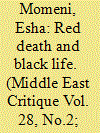

|
|
|
|
|
| Summary/Abstract |
Most of Iran’s urban population experienced the war with Iraq (1980–1988) through the burden of privation and the fear of possible airstrikes. Thus, state-produced media on national television became the main apparatus through which they connected their daily lives to the national conflict. Ravayat-e Fath [The Narrative of Triumph] was one docudrama, comprised of five seasons that the state produced at different intervals between 1984 and 1987. Although Ravayat-e Fath has been presented and received as a journalistic work, it enters the realm of fiction to fulfill its objective: To recruit soldiers. Through a collage of mythical stories, epic narratives, dramatic cinematography, mourning songs accompanied by reports from war fronts, and live interviews with soldiers, the series tells a story of a promised triumph through martyrdom. Through studying Ravayat-e Fath, the most important state-supported television production of the Iran-Iraq war era, this article investigates the ways in which war propaganda in general, and the concept of martyrdom in particular, generated tools like shaming to control the population during and after the war.
|
|
|
|
|
|
|
|
|
|
|
|
|
|
|
|
| 4 |
ID:
167080
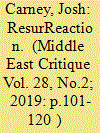

|
|
|
|
|
| Summary/Abstract |
The Turkish TV dramas Magnificent Century and Resurrection Ertuğrul share a number of traits: Both reprise the country’s Ottoman (or proto-Ottoman) past by focusing their story on a heroic figure; both raised the ire of critics for their lack of historicity; and both have been highly successful, ruling ratings on the same competitive Wednesday night prime time slot, with Resurrection coming in to take Century’s place after that show left the air. Despite these similarities, the projects represent quite different takes on the Ottoman past and the issue of history’s role in the Turkish present. While Century arguably partakes in what Svetlana Boym calls reflective nostalgia, Resurrection is a highly restorative project. In this article, I detail the differences between these projects and explain their success in light of the shifting political environment in Turkey. I begin with a characterization of Century and the ‘problem’ it posed for a conservative government that was deeply invested in an idealized Ottoman past. I next turn to Resurrection, which I see as a government reaction to Century, and explain that it succeeds where other imitators failed due to the careful choice of a hero with a relatively blank historical slate. Finally, I argue that Resurrection practices a different attitude toward history than does Century, heralding for a government that not only seeks to glorify and idolize the past, but also to claim ownership of it.
|
|
|
|
|
|
|
|
|
|
|
|
|
|
|
|
| 5 |
ID:
167087
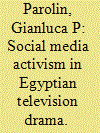

|
|
|
|
|
| Summary/Abstract |
Egyptian Ramadan TV series have explored the relationship between law and television in a number of iterations over the past few years. In 2017, the most watched production (115 million views on YouTube), Kalabsh, went one step further by examining the interaction between television broadcasting and social media in affecting the course of justice. Even though its events revolve around the framing and wrongful incrimination of a ‘good’ police officer, the dynamics suggest a not-so-subtle reference to the January 25, 2011 uprising. It portrayed social media actors as naïve agitators, outsmarted and used by those same dark networks of business and politics that they intend to expose and ultimately to unseat. This representation strengthens the counter-revolution’s narrative of the January 25 uprising as the making of some ‘Facebook kids’ [ʿiyāl bitūʿ il-face]. With Kalabsh, Egyptian TV series recalibrate the representation of the role of television broadcasting in affecting the course of justice and thus produce a new narrative that includes social media. This representation challenges as ‘optimistic’ the reading of the ‘democratic’ nature of social media by showing how its actors are even more prone to falling prey to mystifications and networks of corruption. The centrality of television broadcasting in affecting the course of justice clearly recedes in Kalabsh, but television broadcasting itself seems to regain some reputation.
|
|
|
|
|
|
|
|
|
|
|
|
|
|
|
|
| 6 |
ID:
167088
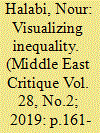

|
|
|
|
|
| Summary/Abstract |
Space has played a central and largely overlooked role in the Syrian conflict during the past eight years. A tension surrounds the organization of urban space and its impact on cultural identity, inequality, and political mobilization. Spatial politics represent a looming threat that is implicit in the project of ISIS, an international terrorist organization that seeks to appropriate the geographical area of al-Sham (Greater Syria) to create a transnational Caliphate. It also appears in the ‘development proposals’ of the Syrian government, which capitalize on a humanitarian crisis to expropriate forcibly displaced citizens of their land and properties.1
1 Signed into law by Syrian President Bashar Al Assad in April 2018, Law number 10 allows the government to seize and redevelop properties in ‘ashwa’iyat or illegal neighborhoods. For more on this see Rania Mostapha (2018Mostapha, R. (2018) Law 10 and the Theft of Syrian Property, Salon Syria. Available at:
https://salonsyria.com/law-10-and-the-theft-of-syrian-property/#.W_s8tPZFxyw
, accessed November 24, 2018.
[Google Scholar]
) Law 10 and the Theft of Syrian Property, in Salon Syria. Available at: https://salonsyria.com/law-10-and-the-theft-of-syrian-property/#.W_s8tPZFxyw, accessed February 4, 2019.
View all notes
This article analyzes how Syrian television drama is not only an important field of cultural expression and a site of contestation but also reveals the many socioeconomic spatial tensions underlying the 2011 Revolution and its aftermath. The latter aspect is demonstrated through a visual and textual analysis of two television serials that depict the ‘ashwa’iyat,2
2 The term ‘ashwa’iyat’ literally translates to ‘arbitraries’ in English, referring to the unregulated, unlicensed and arbitrary fashion in which these slums have been erected and continue to exist. The adjective, in its plural form, has morphed into the common term used to describe the shanty towns surrounding the Damascene urban center.
View all notes
[arbitrary informal settlements of Damascus]. The first show, al-Intizar (2006), aired before the Syrian conflict. The second, Zawal (2016), aired as the political turmoil in Syria continued to unfold. This comparative analysis illustrates how the organization of urban space has impacted the dynamics of the Syrian Revolution and its aftermath, and how portrayals of urban and shanty town dramas portrayed the spatial inequalities of Damascus before and during the conflict.
|
|
|
|
|
|
|
|
|
|
|
|
|
|
|
|
|
|
|
|
|